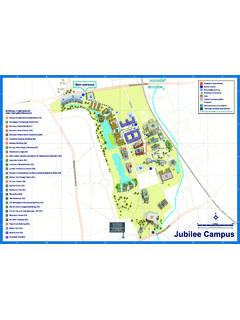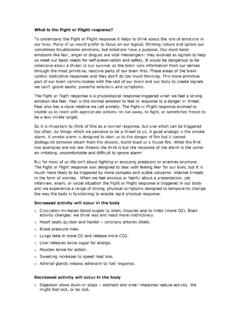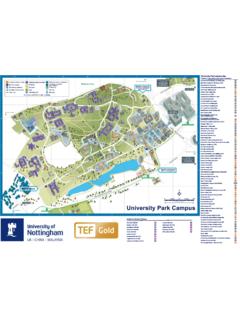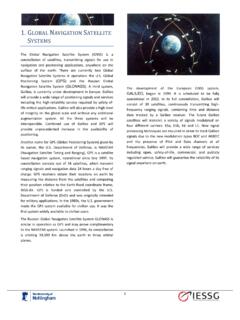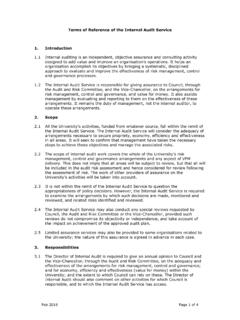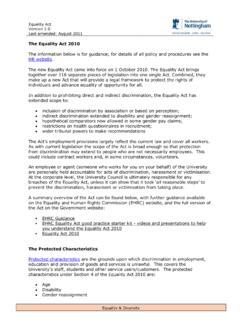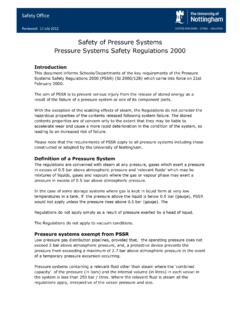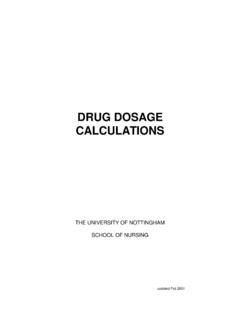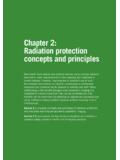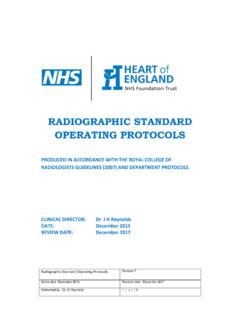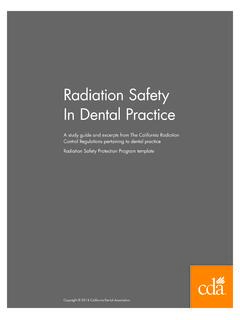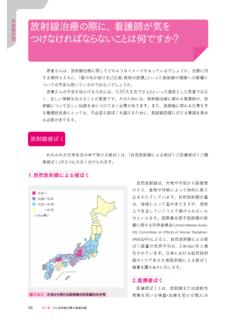Transcription of Safety and Radiation Protection Office Working with X …
1 Safety and Radiation Protection Office Working with X-Ray Equipment Radiation Safety Rules May 2016 2 Radiation Safety Rules X-Ray Equipment General Rules for the Protection of persons exposed to ionising Radiation from sources of x-rays in laboratories at the University of Nottingham. (To be read in conjunction with the Local Rules for any particular area). CONTENTS Principles for the Control of Radiation Exposure Emergencies General Matters Working Arrangements with X-Ray Equipment Safe Practice Procedures for Registering Undergraduate Radioactive Work 3 Organisation for Radiation Safety Director of Health and Safety ( Radiation Protection Officer) The Director of Health and Safety includes the role of University Radiation Protection Officer and acts as the executive officer of the University Safety Committee, putting into effect its decisions relating to the control of Radiation hazards. Matters concerning work involving ionising Radiation are reported to the University Safety Committee.
2 Radiation Protection Advisor Under the Ionising Radiation Regulations 1999 the NUH Medical Physics Department has been appointed as Radiation Protection Adviser, in which capacity they advise the University: on matters of limiting Radiation dose to personnel, as Medical Physics Expert in relation to equipment used for medical exposures, in respect of arrangements for securing compliance with the Environmental Permitting Regulations 2010, and licences issued under this, concerning the acquisition, use and disposal of sources. Radiation Protection Supervisor The Head of any School Working with sources of Radiation shall appoint sufficient Radiation Protection Supervisors to develop and monitor local Radiation Safety arrangements. The Radiation Protection Supervisor shall have appropriate experience and seniority and shall receive appropriate training. Academic Supervisors Academic supervisors are responsible for ensuring that those Working under their supervision receive the necessary training and instruction to enable them to work safely and in accordance with the Local Rules.
3 There should be sufficient supervision to enable the continuing adherence to correct procedure to be monitored 4 Medical Adviser Medical advice concerning exposures to ionising Radiation is obtained through the University s appointed Occupational Health provider: Internal telephone: 14329; External telephone: 9514329 5 Principles for the Control of Radiation Exposure INTRODUCTION These Local Rules are intended to indicate the general arrangements for work with X-ray sources of ionising radiations that are in force at this University. These arrangements put into practice the requirements of the Ionising Radiations Regulations 1999. For the purpose of these Local Rules work with ionising Radiation includes: 1. Work involving X-ray equipment 2. Work involving electrical equipment emitting ionisation Radiation at a potential difference of more than 5,000 volts cathode ray tubes. The use of X-ray equipment for the exposure of human subjects is also controlled by the Ionising Radiation (Medical Exposure) Regulations 2000.
4 The Radiation risks must be assessed for any new, modified or relocated equipment so that the Radiation Protection requirements can be identified and provided before first use. Consequently all X-ray generating equipment must be: Pre-notified to and approved by the Safety Office Recorded onto site and the location kept up to date, Subjected to a Critical Examination to ensure that all Safety features and warning indicators are functioning correctly and that dose-rates are within design specifications, Access restricted and under the supervision of a designated person, Regularly checked for leakage and recorded. 6 For further information please see: Management of X-ray Generating Equipment For each area in which ionising Radiation is used (Controlled or Supervised) there are additional Local Area Rules giving details of the area and of the detailed procedures to be used therein. Together these comprise the "local rules for the purpose of enabling work with ionising Radiation to be carried out in compliance with the requirements of the Regulations" Each member of the University Working with sources of ionising Radiation is required to have his/her own personal copy of the Local Rules and to certify that it has been read and its contents understood.
5 In each area there has been appointed a Radiation Protection Supervisor responsible for ensuring that all work in the area is carried out in accordance with the Rules, and all workers must ensure that they are aware of who the RPS is for any area they enter. No one may enter a designated Radiation area (controlled or supervised area) without being aware of the Local Rules for that area. When in the area they must conform to those Rules and with any written system of work in place. This applies both to Radiation workers and to all other staff or visitors who may enter the area, including for example cleaners, security staff and contractors. MEDICAL SUPERVISION OF CLASSIFIED WORKERS Certain work may require that a person shall be designated as a Classified Worker and subject to medical supervision. In this case a satisfactory pre-employment medical examination is required before commencing the work. Subsequent examinations are not routinely required but may be carried out if a particular need arises, for example a significant Radiation dose received by the worker.
6 The examinations are carried out by the University s 7 Occupational Health provider with the records maintained under strict medical confidentiality by them. NEW WORK PRIOR RISK ASSESSMENT AND APPROVAL All proposals for new work and/or equipment must be submitted for approval before being put into effect. A special proposal form should be completed and returned to the Safety Office . Approval will only be given when the University Radiation Protection Officer is satisfied that the risks associated with the work have been adequately assessed and the proposed Working arrangements and laboratory facilities to control these are satisfactory. In each case there will be one supervisor nominated as taking full responsibility for radiological Safety in the proposed work. For Radiation work involving undergraduates, laboratory practicals or research projects, there are particular requirements on authorising the work and registration of the student. These are summarised in the table in the appendix.
7 The undergraduates must receive written information setting out the hazards of the work, the precautions to be followed and any conditions under which they are taking part in the project. EMERGENCIES IN Radiation AREAS In the event of an incident thought to involve accidental personal exposure, or in the case of fire, the Radiation Protection Supervisor and the Radiation Protection Officer must be informed immediately. Outside normal Working hours they should be contacted by telephone via University Security. Emergency arrangements for each Radiation area should be included in the Area Local Rules. Radiation workers should be familiar with the action necessary to be taken to deal with the situation. Radiation workers should be familiar with the arrangements made by the University in the event of fire and for summoning an ambulance. These arrangements are detailed in a printed notice displayed in each Radiation laboratory. 8 THE TREATMENT OF SERIOUS INJURIES MUST TAKE PRECEDENCE OVER OTHER REMEDIAL ACTION.
8 In the case of an emergency arising from an apparatus producing ionising radiations, the apparatus should be switched off at once. General Matters It is a principle of Radiation Protection in general and of the Regulations in particular that the University must make arrangements to limit the exposure to all persons as far as reasonably practicable. The University will inform individuals of these arrangements when they first register to undertake work with ionising Radiation . No work with ionising Radiation may be undertaken by unregistered workers, or otherwise not in accordance with the control procedures relating to teaching practicals. REGISTRATION OF Radiation WORKERS All persons, with the exception under certain circumstances of undergraduate students (see appendix), Working with X-ray equipment must be registered with the Safety and Radiation Protection Office . A worker registration form, countersigned by the person s Radiation Protection Supervisor, must be submitted to the Safety and Radiation Protection Office .
9 If considered appropriate a personal Radiation dosimeter will be issued. The person may not commence work until the registration process has been completed. INFORMATION, INSTRUCTION AND TRAINING Introductory sessions on the principles of Radiation Protection are held at University Park and Sutton Bonington in the autumn and early spring of each year. All new Radiation workers are required to attend the first available session. Further instructions on training specific to the individual s work will be given within their School. The notes relating to this are available from the Safety Office web site. 9 Thereafter every individual Working with ionising radiations or radioactive substances has a duty to protect themselves and others from any hazard arising from their work. They must not expose themselves or others to ionising radiations to a greater extent than is reasonably necessary for the purpose of their work. Any such exposure must be as low as is reasonable achievable .
10 All Radiation workers must be aware of the general safe Working principles and must attend all training sessions arranged by their School, and be aware of the particular procedures applying within any controlled, supervised or registered area they may enter. (These are available from the Radiation Protection Supervisor whose name is displayed on the notice at the entrance to the area). PERSONAL DOSEMETERS Radiation workers are responsible for the care and correct use of their personal Radiation dosimeter. In particular it must be worn when carrying out Radiation work and at other times kept in an area away from sources of external Radiation . The dosimeter must be available for prompt exchange at the end of the wear period, usually 3 months. Loss of a dosimeter will incur a charge to the School. The Safety Office receives a quarterly report of dosimeter readings. These are reviewed by the Safety and Radiation Protection Officer. Annual investigation levels are set at 1mSv pa annual whole body dose, 4mSv extremities.

